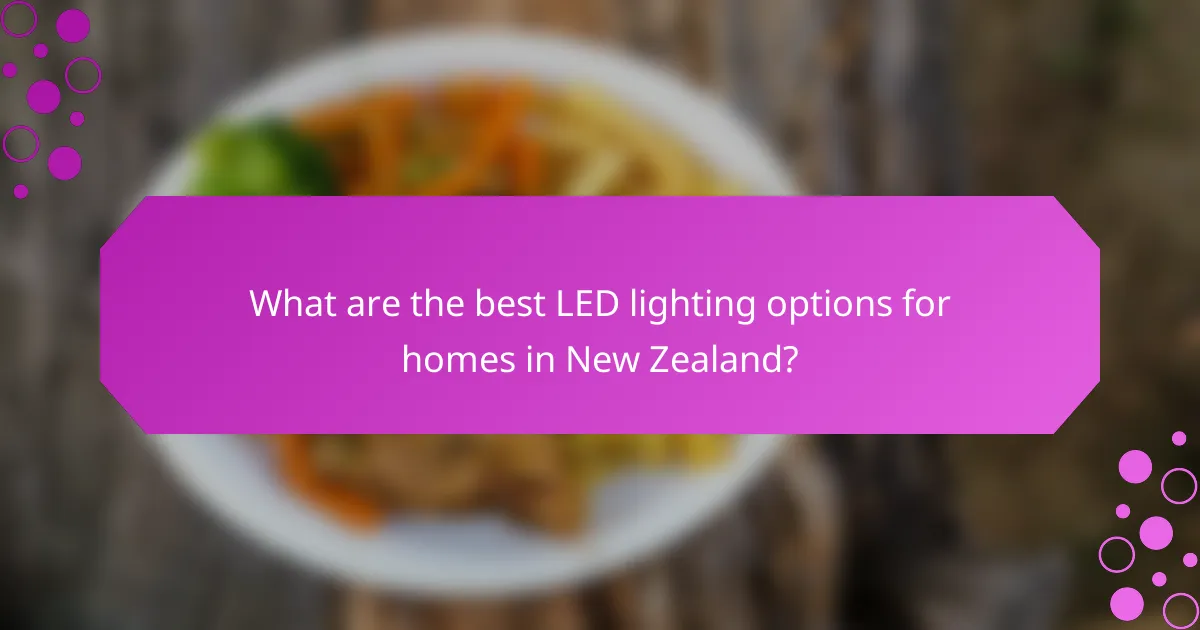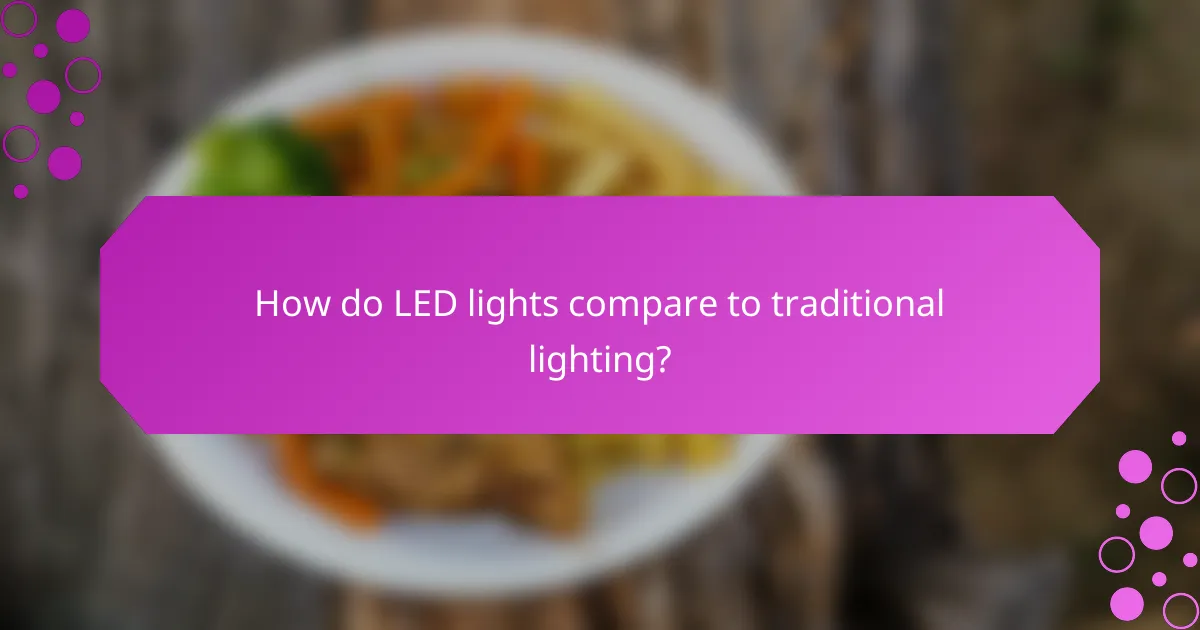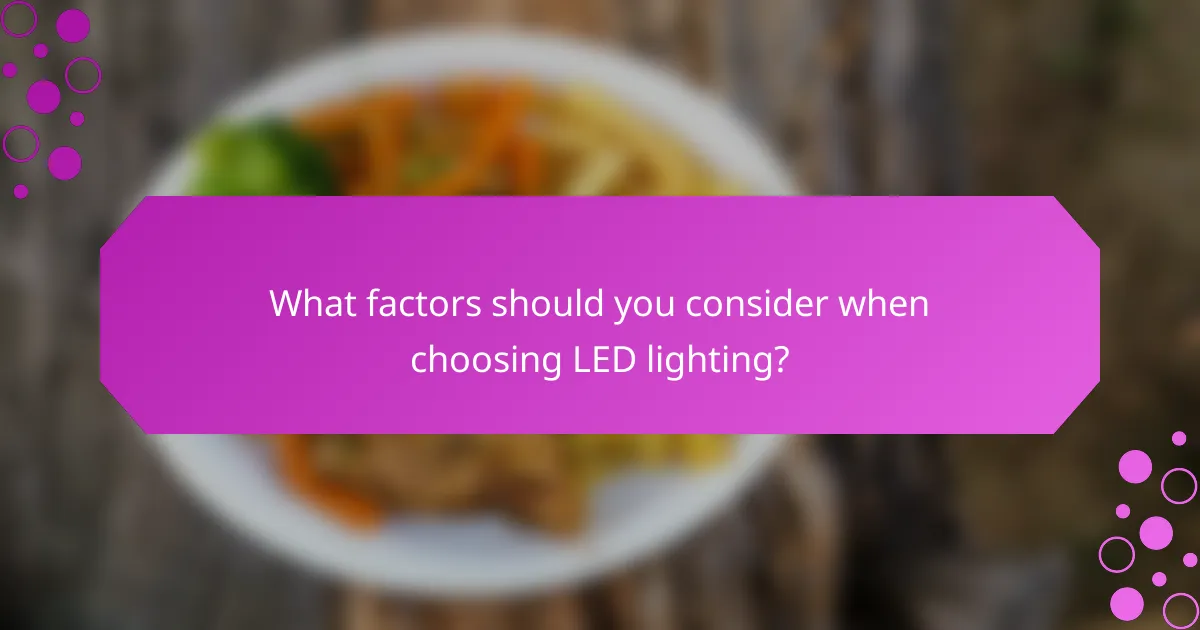LED lighting is revolutionizing the way we illuminate our spaces, offering significant energy efficiency and longevity compared to traditional bulbs. With their stylish designs and variety of options, such as smart bulbs and downlights, LED lights not only reduce electricity consumption but also enhance the aesthetic appeal of any home. Embracing LED technology contributes to a more sustainable environment while keeping utility bills in check.

How do LED lights improve energy efficiency in New Zealand?
LED lights significantly enhance energy efficiency in New Zealand by consuming less electricity compared to traditional lighting options. This reduction in energy use not only lowers utility bills but also contributes to a more sustainable environment.
Lower energy consumption
LED lights use up to 80% less energy than incandescent bulbs, making them a cost-effective choice for households and businesses. For example, replacing a 60-watt incandescent bulb with a 10-watt LED can lead to substantial savings on electricity bills over time.
In New Zealand, where electricity prices can be relatively high, the switch to LED lighting can result in noticeable reductions in monthly expenses. This energy efficiency is particularly beneficial for larger installations, such as office buildings or retail spaces.
Longer lifespan
LED lights have a lifespan of approximately 15,000 to 50,000 hours, far exceeding that of traditional bulbs, which typically last around 1,000 hours. This longevity means fewer replacements and lower maintenance costs over time.
In practical terms, using LED lighting can reduce the frequency of bulb changes, which is especially advantageous for hard-to-reach fixtures. This durability also contributes to less waste, aligning with New Zealand’s commitment to sustainability.
Reduced carbon footprint
By consuming less energy and lasting longer, LED lights help decrease greenhouse gas emissions associated with electricity generation. This is particularly relevant in New Zealand, where a significant portion of electricity comes from renewable sources.
Switching to LED lighting can play a crucial role in reducing an individual or organization’s overall carbon footprint. For those looking to make environmentally conscious choices, adopting LED technology is a straightforward and impactful step.

What are the best LED lighting options for homes in New Zealand?
The best LED lighting options for homes in New Zealand include smart bulbs, downlights, and specialty bulbs that enhance color and brightness. These products offer energy efficiency, longevity, and stylish designs suitable for various home environments.
Philips Hue smart bulbs
Philips Hue smart bulbs are popular for their versatility and connectivity. They can be controlled via smartphone apps or voice assistants, allowing users to adjust brightness and color temperature easily.
These bulbs typically range from 800 to 1600 lumens, making them suitable for different lighting needs. They also support various color options, enabling personalized ambiance for any occasion.
Osram LED downlights
Osram LED downlights provide a sleek, modern look while delivering efficient lighting. They are ideal for recessed installations in kitchens, living rooms, or bathrooms.
These downlights often feature adjustable brightness levels and color temperatures, with wattages ranging from 5 to 15 watts. This flexibility allows homeowners to create the desired atmosphere while saving on energy costs.
GE Reveal LED bulbs
GE Reveal LED bulbs are designed to enhance the appearance of colors in your home. These bulbs emit a bright, white light that makes colors appear more vibrant and true to life.
With a lifespan of around 25,000 hours, they are a long-lasting option for general lighting. Available in various wattages, they can replace traditional incandescent bulbs, providing significant energy savings while improving the overall look of your space.

How do LED lights compare to traditional lighting?
LED lights are generally more energy-efficient, longer-lasting, and stylish compared to traditional lighting options like incandescent and fluorescent bulbs. They consume less power, have a longer lifespan, and offer a variety of designs and colors that can enhance any space.
Cost savings over time
LED lights can significantly reduce electricity bills due to their lower energy consumption. While the initial purchase price may be higher than traditional bulbs, the long lifespan of LEDs—often exceeding 15,000 hours—means they need to be replaced less frequently, leading to further savings on replacement costs.
For example, switching to LED lighting can save households and businesses tens to hundreds of dollars annually, depending on usage and local electricity rates. This makes them a cost-effective choice in the long run.
Brightness and color quality
LED lights provide excellent brightness and can emit a wide range of color temperatures, from warm white to cool daylight. This versatility allows users to select lighting that best suits their environment, enhancing both functionality and aesthetics.
In comparison to traditional bulbs, LEDs maintain their brightness over time without significant dimming, ensuring consistent lighting quality. This is particularly beneficial in settings where precise lighting is essential, such as in retail or art galleries.
Heat emission differences
One of the key advantages of LED lights is their low heat emission. Unlike incandescent bulbs, which convert a large portion of energy into heat, LEDs remain cool to the touch, reducing the risk of burns and lowering cooling costs in warmer climates.
This characteristic not only improves safety but also enhances energy efficiency, as less energy is wasted as heat. In environments where lighting is used for extended periods, such as offices or homes, this can lead to a more comfortable atmosphere and lower air conditioning expenses.

What factors should you consider when choosing LED lighting?
When selecting LED lighting, consider wattage and lumens, color temperature, and compatibility with dimmers. These factors influence energy efficiency, brightness, and the overall ambiance of your space.
Wattage and lumens
Wattage refers to the amount of energy an LED bulb uses, while lumens measure the brightness produced. Generally, lower wattage with higher lumens indicates a more efficient bulb. For instance, a 10-watt LED can produce around 800 lumens, comparable to a traditional 60-watt incandescent bulb.
When choosing LED lighting, aim for bulbs that provide sufficient lumens for your needs without excessive wattage. A good rule of thumb is to consider the lumens needed per square meter based on the room’s purpose—living areas may require around 100-150 lumens per square meter, while task areas like kitchens might need 300-400 lumens.
Color temperature
Color temperature, measured in Kelvin (K), affects the mood and functionality of a space. Lower values (around 2700K-3000K) produce warm white light, ideal for cozy environments, while higher values (4000K-5000K) yield cool white or daylight tones, suitable for workspaces.
When selecting color temperature, consider the activities in each room. For example, use warmer tones in bedrooms and living rooms for relaxation, while cooler tones can enhance focus in offices or kitchens. Many LED options now offer adjustable color temperatures for versatile lighting solutions.
Compatibility with dimmers
Not all LED bulbs are compatible with dimmer switches, which can lead to flickering or buzzing. Ensure the LED lighting you choose is specifically labeled as dimmable to avoid these issues. Look for bulbs that mention compatibility with standard dimmer types.
When installing dimmable LEDs, consider using a compatible dimmer switch designed for LED technology. This helps maintain smooth dimming performance and extends the lifespan of both the bulbs and the dimmer. Always check the manufacturer’s specifications for maximum wattage and load requirements to ensure optimal performance.

What are the latest trends in LED lighting design?
The latest trends in LED lighting design focus on smart integration, decorative aesthetics, and energy efficiency. These advancements not only enhance functionality but also contribute to stylish and sustainable living environments.
Smart home integration
Smart home integration in LED lighting allows users to control their lighting systems remotely through smartphones or voice-activated devices. This trend enhances convenience and energy savings, as users can schedule lights to turn on or off based on their routines.
Consider systems compatible with platforms like Amazon Alexa or Google Assistant for seamless integration. Look for LED bulbs that offer features such as dimming, color changing, and programmable settings to maximize functionality.
Decorative LED fixtures
Decorative LED fixtures are becoming increasingly popular as they combine style with energy efficiency. These fixtures come in various designs, from minimalist to ornate, allowing homeowners to express their personal style while benefiting from the longevity of LED technology.
When selecting decorative fixtures, consider the color temperature and brightness to create the desired ambiance. Options like pendant lights, chandeliers, and wall sconces can transform a space while providing effective illumination.
Energy-efficient outdoor lighting
Energy-efficient outdoor lighting is essential for enhancing safety and aesthetics while reducing energy consumption. LED options for outdoor spaces include pathway lights, floodlights, and garden lights, all designed to withstand various weather conditions.
When choosing outdoor LED lights, look for products with high lumen output and low wattage to ensure brightness without excessive energy use. Additionally, consider solar-powered LED lights for an eco-friendly option that requires minimal maintenance.

How can you maximize the lifespan of LED lights?
To maximize the lifespan of LED lights, ensure proper installation, use compatible dimmers, and maintain optimal operating conditions. Following these guidelines can significantly extend their longevity and performance.
Choose the right wattage
Selecting the appropriate wattage is crucial for maximizing LED lifespan. Using a wattage that is too high can lead to overheating, while too low can result in insufficient brightness. Always refer to the manufacturer’s specifications for guidance on wattage compatibility.
Avoid frequent on-off cycling
Frequent switching can shorten the lifespan of LED lights. Try to minimize the number of times you turn them on and off, especially if they are not designed for rapid cycling. Consider using timers or smart home systems to manage usage effectively.
Maintain optimal temperature
LED lights perform best in cooler environments. Excessive heat can reduce their lifespan significantly. Ensure proper ventilation around fixtures and avoid placing them in enclosed spaces without adequate airflow.
Use quality fixtures and drivers
Investing in high-quality fixtures and drivers can enhance the lifespan of your LED lights. Poor-quality components may not regulate power effectively, leading to flickering or premature failure. Look for products that meet recognized standards for safety and performance.
